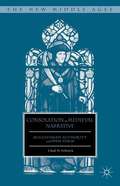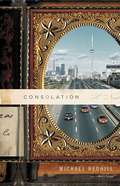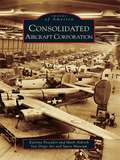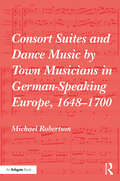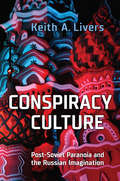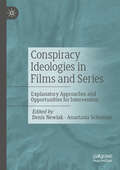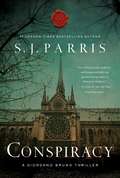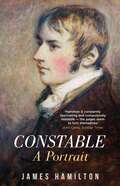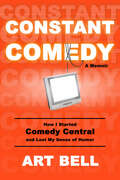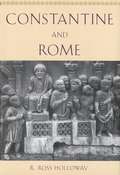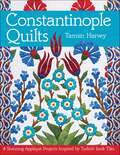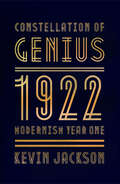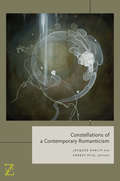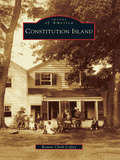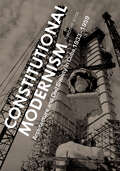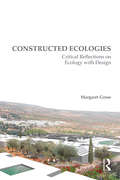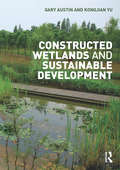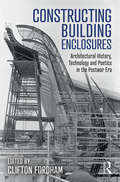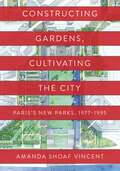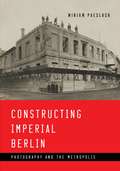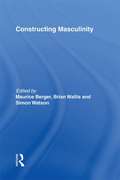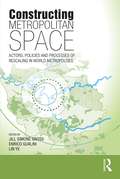- Table View
- List View
Consolation in Medieval Narrative: Augustinian Authority and Open Form (The New Middle Ages)
by Chad D. SchrockMedieval writers such as Chaucer, Abelard, and Langland often overlaid personal story and sacred history to produce a distinct narrative form. The first of its kind, this study traces this widely used narrative tradition to Augustine's two great histories: Confessions and City of God.
Consolation: A Novel
by Michael RedhillHistorian David Hollis believes he has found a treasure of incalculable value: a trove of old photographs, the earliest pictures ever taken of a great city in its earliest days. The glass negatives, he is certain, were in a strongbox on a ship that sank in the city's harbor a century and a half earlier. That wreck, by his calculations, is beneath a landfill in the process of being excavated for a new sports arena. If construction can be halted for a search, a unique record of the city's birth might be reclaimed for all. David's quest is unfulfilled at the time of his death, and his widow, Marianne, takes up the challenge. Confronting skepticism and resistance, she learns more about Jem Hallam, the immigrant photographer whose pictures become her grail. In a masterful interweaving of two centuries, Consolation unfolds the story of Jem Hallam's life alongside Marianne's search. What brought him from England to the new and still primitive town of Toronto? Why did he leave his wife and children behind? What drove him to photograph this young metropolis in such vivid detail? Consolation moves back and forth between the stories of David's legacy and of Jem Hallam's life, revealing a mysterious connection. Nothing less than survival itself is at stake for Jem Hallam, while love and pride drive Marianne Hollis's effort to vindicate her late husband. Michael Redhill makes each element of his unforgettable story both profound and suspenseful, brilliantly illuminating how time and grief alter the contours of even the things we think we know for certain. It is the work of a writer at the top of his form.
Consolidated Aircraft Corporation (Images of America)
by San Diego Air and Space Museum Katrina Pescador Mark AldrichFounded by Reuben H. Fleet in 1923, Consolidated Aircraft Corporation (later Convair) became one of the most significant aircraft manufacturers in American history. For roughly 60 years, this prolific company was synonymous with San Diego. In fact, whole sections of the city were designed to provide homes for the Convair workers and their families. These men and women were responsible for building some of the most significant aircraft in aviation history, including the PBY Catalina, B-24 Liberator, F-102 Delta Dagger, as well as the reliable Atlas missile, which was vital in launching America into space. To this day, more than a decade after the company passed from the San Diego scene, tens of thousands of San Diegans still celebrate a seminal connection with Reuben Fleet, his company, and his popular slogan, "Nothing short of right is right."
Consort Suites and Dance Music by Town Musicians in German-Speaking Europe, 1648–1700
by Michael RobertsonThis companion volume to The Courtly Consort Suite in German-Speaking Europe surveys an area of music neglected by modern scholars: the consort suites and dance music by musicians working in the seventeenth-century German towns. Conditions of work in the German towns are examined in detail, as are the problems posed by the many untrained travelling players who were often little more than beggars. The central part of the book explores the organisation, content and assembly of town suites into carefully ordered printed collections, which refutes the concept of the so-called 'classical' suite. The differences between court and town suites are dealt with alongside the often-ignored variation suite from the later decades of the seventeenth century and the separate suite-writing traditions of Leipzig and Hamburg. While the seventeenth-century keyboard suite has received a good deal of attention from modern scholars, its often symbiotic relationship with the consort suite has been ignored. This book aims to redress the balance and to deal with one very important but often ignored aspect of seventeenth-century notation: the use of blackened notes, which are rarely notated in a meaningful way in modern editions, with important implications for performance.
Conspiracy Culture: Post-Soviet Paranoia and the Russian Imagination
by Keith A. LiversContemporary Russia stands apart as one of the most prolific generators of conspiracy theories and paranoid rhetoric. Conspiracy Culture traces the roots of the phenomenon within the sphere of culture and history, examining the long arc of Russian paranoia from the present moment back to earlier nineteenth-century sources, such as Dostoevsky’s anti-nihilist novel Demons. Conspiracy Culture examines the use of conspiracy tropes by contemporary Russian authors and filmmakers including the postmodernist writer Viktor Pelevin, the conservative author and pundit Aleksandr Prokhanov, and the popular director Timur Bekmambetov. It also explores paranoia as an instrument within contemporary Russian political rhetoric, as well as in pseudo-historical works. What stands out is the manner in which popular paranoia is utilized to express broadly shared fears not only of a long-standing anti-Russian conspiracy undertaken by the West, but also about the destruction of the country’s cultural and spiritual capital within this imagined "Russophobic" plot.
Conspiracy Ideologies in Films and Series: Explanatory Approaches and Opportunities for Intervention
by Denis Newiak Anastasia SchnitzerCorona as a staged instrument of oppression, secretly kept vaccination deaths or politicians drinking children's blood: at the latest since the outbreak of the Covid 19 pandemic, conspiracy ideologies are booming and harm social peace and democratic will formation through their dogmatism. So-called conspiracy theories generate systematic distrust of legitimate political institutions and can contribute to social polarization, dangerous populism and extremist escalation. Conspiracy ideologies have always been a topic in movies and television series, as they have always dealt with the relationship between reality and illusion, truth and fiction, reality and dream, sense and madness through their cinematic means. Series and films not only serve as a discursive space for social self-understanding, but also, through their complex narratives, constellations of characters and aesthetics, offer catchy explanations for the emergence and spread of conspiracy narratives. At the same time, theymake suggestions, some of them astonishingly concrete, for dealing with such collective delusions. What can we learn from the fictional worlds of series and films for dealing with this very real contemporary phenomenon?
Conspiracy: A Giordano Bruno Thriller (Giordano Bruno Mysteries)
by SJ ParrisA gripping murder mystery set in 16th-century France, as Giordano Bruno fights against multiple factions manipulating the succession of King Henry III.December 1585: King Henry III of France is the last of his line. He has appointed a Protestant as his successor, which has caused a three-way war in his country. As a result, the king is in mortal fear of a coup being orchestrated by the ultra-conservative Catholic League. Radical philosopher, ex-monk and spy Giordano Bruno, forced to return to Paris, is called upon by King Henry to unearth the motivation behind several mysterious but linked deaths. Each victim is connected to a larger plot to manipulate the royal succession; what they knew and who killed them is a mystery to be solved. Meanwhile, Bruno makes an uneasy alliance with Charles Paget, a key figure in the community of English Catholics who tried to assassinate Queen Elizabeth. When Bruno is implicated in the death of Leonie, a member of the Queen Mother's "Flying Squadron," he is forced to call on Paget and his connections for help—and finds that it comes with a price, involving an old enemy.
Constable: A Portrait
by James HamiltonONE OF THE TIMES AND SUNDAY TIMES' BEST BOOKS FOR 2022'Eye-opening and full of surprises . . . A treasure' Sunday TimesJohn Constable, the revolutionary nineteenth-century painter of the landscapes and skies of southern England, is Britain's best-loved but perhaps least understood artist.His paintings reflect visions of landscape that shocked and perplexed his contemporaries: attentive to detail, spontaneous in gesture, brave in their use of colour. What we learn from his landscapes is that Constable had sharp local knowledge of Suffolk, a clarity of expression of the skyscapes above Hampstead, an understanding of the human tides in London and Brighton, and a rare ability in his late paintings of Salisbury Cathedral to transform silent suppressed passion into paint.Yet Constable was also an active and energetic correspondent. His letters and diaries - there are over one thousand letters from and to him - reveal a man of passion, opinion and discord, while his character and personality is concealed behind the high shimmering colour of his paintings. They reveal too the lives and circumstances of his brothers and his sisters, his cousins and his aunts, who serve to define the social and economic landscape against which he can be most clearly seen. These multifaceted reflections draw a sharp picture of the person, as well as the painter.James Hamilton's biography reveals a complex, troubled man, and explodes previous mythologies about this timeless artist, and establishes him in his proper context as a giant of European art.
Constable: A Portrait
by James HamiltonONE OF THE TIMES AND SUNDAY TIMES' BEST BOOKS FOR 2022'Eye-opening and full of surprises . . . A treasure' Sunday Times'A biography as rich with colourful characters as any novel' TelegraphJohn Constable, the revolutionary nineteenth-century painter of the landscapes and skies of southern England, is Britain's best-loved but perhaps least understood artist.His paintings reflect visions of landscape that shocked and perplexed his contemporaries: attentive to detail, spontaneous in gesture, brave in their use of colour. What we learn from his landscapes is that Constable had sharp local knowledge of Suffolk, a clarity of expression of the skyscapes above Hampstead, an understanding of the human tides in London and Brighton, and a rare ability in his late paintings of Salisbury Cathedral to transform silent suppressed passion into paint.Yet Constable was also an active and energetic correspondent. His letters and diaries - there are over one thousand letters from and to him - reveal a man of passion, opinion and discord, while his character and personality is concealed behind the high shimmering colour of his paintings. They reveal too the lives and circumstances of his brothers and his sisters, his cousins and his aunts, who serve to define the social and economic landscape against which he can be most clearly seen. These multifaceted reflections draw a sharp picture of the person, as well as the painter.James Hamilton's biography reveals a complex, troubled man, and explodes previous mythologies about this timeless artist, and establishes him in his proper context as a giant of European art.
Constant Comedy: How I Started Comedy Central and Lost My Sense of Humor
by Art BellThis insider’s memoir about the origins of Comedy Central is “a very, very funny book about an amazing piece of comedy history” (Jerry Zucker, cowriter and director of Airplane!).Finalist, 2020 Best Book Awards sponsored by American Book FestIn 1988, a young, mid-level employee named Art Bell pitched a novel concept—a television channel focused 100% on just one thing: comedy—to the chairman of HBO. The station that would soon become Comedy Central, with celebrated programs like South Park, Chapelle’s Show, The Daily Show, and The Colbert Report, was born.Constant Comedy takes you behind the scenes into the comedy startup on its way to becoming one of the most successful and creative purveyors of popular culture in the United States. From disastrous pitch meetings with comedians to the discovery of talents like Bill Maher and Jon Stewart, this intimate biography peers behind the curtain and reveals what it’s really like to work, struggle, and ultimately succeed at the cutting edge of show business. “The funniest behind-the-scenes memoir I’ve ever read, full of crazy characters, plot twists, and suspense.” —Dan Lyons, New York Times-bestselling author of Disrupted
Constantine and Rome
by R. Ross Holloway"Constantine the Great (285-337) played a crucial role in mediating between the pagan, imperial past of the city of Rome, which he conquered in 312, and its future as a Christian capital. In this book, R. Ross Holloway draws on archaeological evidence to examine Constantine's remarkable building program in Rome, describing a cityscape that was at once Christian and pagan, mirroring the personality of its ruler. " "Holloway begins by examining the Christian Church in the period before the Peace of 313, when Constantine and his coemperor Licinius ended persecution of the Christians. He then focuses on the structure, style, and significance of important monuments. He discusses the Arch of Constantine, suggesting that it was begun by Constantine's predecessor Maxentius but finished, with modifications, for the new emperor. He looks at the basilicas of the Constantinian period, including St. John's in the Lateran and St. Peter's, and the imperial mausoleum and basilica at Tor Pignatara on the Via Labicana, which he contends is one of the most innovative complexes in the history of Western architecture. Holloway next surveys the Christian cemeteries of the period and reviews evidence for adaptation of pagan buildings to Christian worship. In a final chapter Holloway advances a new interpretation of the archaeology of the Tomb of St. Peter under the high altar of St. Peter's basilica. The tomb, he concludes, was not the original resting place of the remains venerated as those of the apostle but was created only in 251 by Pope Cornelius. "--BOOK JACKET. Title Summary field provided by Blackwell North America, Inc. All Rights Reserved
Constantinople Quilts: 8 Stunning Appliqué Projects Inspired by Turkish Iznik Tiles
by Tamsin HarveyTravel to an exotic land with timeless designs inspired by Turkish Iznik tiles from the Ottoman Empire. Bursting with flora and organic symmetry, the book’s exquisite fusible appliqué projects will take your breath away. Your journey begins with the basics—choosing the right fabric, thread, and needles for hand-stitched or machine appliqué. Newer or busy quilters can start with table runners or bags and work their way up to Tamsin Harvey’s stunning master quilts. Location photography enhances 8 patterns that effortlessly go from ancient places to contemporary spaces. • 8 striking fusible appliqué projects designed from ancient tile work are included. • Travel photography throughout the book shows real-life examples of the intricate tile inspiration. • Designs include large and small projects suited to quilters of all skill levels
Constellation of Genius: 1922, Modernism Year One
by Kevin JacksonEzra Pound referred to 1922 as Year One of a new era. It was the year that began with the publication of James Joyce's Ulysses and ended with the publication of T. S. Eliot's The Waste Land, two works that were arguably "the sun and moon" of modernist literature, some would say of modernity itself.In Constellation of Genius, Kevin Jackson puts the titanic achievements of Joyce and Eliot in the context of the world in which their works first appeared. As Jackson writes in his introduction, "On all sides, and in every field, there was a frenzy of innovation." It is in 1922 that Hitchcock directs his first feature; Kandinsky and Klee join the Bauhaus; the first AM radio station is launched; Walt Disney releases his first animated shorts; and Louis Armstrong takes a train from New Orleans to Chicago, heralding the age of modern jazz. On other fronts,Einstein wins the Nobel Prize in Physics, insulin is introduced to treat diabetes, and the tomb of Tutankhamun is discovered. As Jackson writes, the sky was "blazing with a ‘constellation of genius' of a kind that had never been known before, and has never since been rivaled."Constellation of Genius traces an unforgettable journey through the diaries of the actors, anthropologists, artists, dancers, designers, filmmakers, philosophers, playwrights, politicians, and scientists whose lives and works—over the course of twelve months—brought a seismic shift in the way we think, splitting the cultural world in two. Was this a matter of inevitability or of coincidence? That is for the reader of this romp, this hugely entertaining chronicle, to decide.
Constellations of a Contemporary Romanticism (Lit Z)
by Jacques Khalip & Forest Pyle, editorsConstellations of a Contemporary Romanticism takes its title and point of departure from Walter Benjamin’s concept of the historical constellation, which puts both “contemporary” and “romanticism” in play as period designations and critical paradigms. Featuring fascinating and diverse contributions by an international roster of distinguished scholars working in and out of romanticism—from deconstruction to new historicism, from queer theory to postcolonial studies, from visual culture to biopolitics—this volume makes good on a central tenet of Benjamin’s conception of history: These critics “grasp the constellation” into which our “own era has formed with a definite earlier one.” Each of these essays approaches romanticism as a decisive and unexpired thought experiment that makes demands on and poses questions for our own time: What is the unlived of a contemporary romanticism? What has romanticism’s singular untimeliness bequeathed to futurity? What is romanticism’s contemporary “redemption value” for painting and politics, philosophy and film?
Constitution Island (Images of America)
by Ronnie Clark CoffeyRugged in beauty and rich in history, Constitution Island lies at a picturesque bend of the Hudson River, opposite West Point and north of New York City. As the location of the first fortifications built to defend American independence, it was the anchor site of the great chain, which stretched across the Hudson to impede British passage. During the 19th century, it was the home of two extraordinary sisters, Susan and Anna Warner. Raised in wealth and comfort, they struggled with their father's economic ruin during the panic of 1837. Accomplished and resourceful, they turned to writing for a living. Susan's best-selling novel, The Wide, Wide World, made her a celebrity, while her sister Anna's hymn, "Jesus Loves Me," became known around the globe. In 1916, a devoted group of friends and admirers began a volunteer organization, the Constitution Island Association, to preserve the home, gardens, and memory of the Warner sisters and their historic island.
Constitutional Modernism: Architecture and Civil Society in Cuba, 1933-1959
by Timothy HydeHow does architecture make its appearance in civil society? Constitutional Modernism pursues this challenging question by exploring architecture, planning, and law as cultural forces. Analyzing the complex entanglements between these disciplines in the Cuban Republic, Timothy Hyde reveals how architects joined with other professionals and intellectuals in efforts to establish a stable civil society, from the promulgation of a new Cuban Constitution in 1940 up until the Cuban Revolution.By arguing that constitutionalism was elaborated through architectural principles and practices as well as legal ones, Hyde offers a new view of architectural modernism as a political and social instrument. He contends that constitutionalism produced a decisive confluence of law and architecture, a means for planning the future of Cuba. The importance of architecture in this process is laid bare by Hyde&’s thorough scrutiny of a variety of textual, graphical, and physical artifacts. He examines constitutional articles, exhibitions, interviews, master plans, monuments, and other primary materials as acts of design.Read from the perspective of architectural history, Constitutional Modernism demonstrates how the modernist concepts that developed as an international discourse before the Second World War evolved through interactions with other disciplines into a civil urbanism in Cuba. And read from the perspective of Cuban history, the book explains how not only material products such as buildings and monuments but also the immaterial methods of architecture as a cultural practice produced ideas that had consequential effects on the political circumstances of the nation.
Constructed Ecologies: Critical Reflections on Ecology with Design
by Margaret GroseToday, designers are shifting the practice of landscape architecture towards the need for a more complex understanding of ecological science. Constructed Ecologies presents ecology as critical theory for design, and provides major ideas for design that are supported with solid and imaginative science. In the questioning narrative of Constructed Ecologies, the author discards many old and tired theories in landscape architecture. With detailed documentation, she casts off the savannah theory, critiques the search for universals, reveals the needed role of designers in large-scale agriculture, abandons the overlay technique of McHarg, and introduces the ecological and urban health urgency of public night lighting. Margaret Grose presents wide-ranging new approaches and shows the importance of learning from science for design, of going beyond assumptions, of working in multiple rather than single issues, of disrupting linear design thinking, and of dealing with data. This book is written with a clear voice by an ecologist and landscape architect who has led design students into loving ecological science for the support it gives design.
Constructed Wetlands and Sustainable Development
by Gary Austin Kongjian YuThis book explains how with careful planning and design, the functions and performance of constructed wetlands can provide a huge range of benefits to humans and the environment. It documents the current designs and specifications for free water surface wetlands, horizontal and vertical subsurface flow wetlands, hybrid wetlands and bio retention basins; and explores how to plan, engineer, design and monitor these natural systems. Sections address resource management (landscape planning), technical issues (environmental engineering and botany), recreation and physical design (landscape architecture), and biological systems (ecology). Site and municipal scale strategies for flood management, storm-water treatment and green infrastructure are illustrated with case studies from the USA, Europe and China, which show how these principles have been put into practice. Written for upper level students and practitioners, this highly illustrated book provides designers with the tools they need to ensure constructed wetlands are sustainably created and well manage
Constructing Building Enclosures: Architectural History, Technology and Poetics in the Postwar Era
by Clifton FordhamConstructing Building Enclosures investigates and interrogates tensions that arose between the disciplines of architecture and engineering as they wrestled with technology and building cultures that evolved to deliver structures in the modern era. At the center of this history are inventive architects, engineers and projects that did not settle for conventional solutions, technologies and methods. Comprised of thirteen original essays by interdisciplinary scholars, this collection offers a critical look at the development and the purpose of building technology within a design framework. Through two distinct sections, the contributions first challenge notions of the boundaries between architecture, engineering and construction. The authors then investigate twentieth-century building projects, exploring technological and aesthetic boundaries of postwar modernism and uncovering lessons relevant to enclosure design that are typically overlooked. Projects include Louis Kahn’s Weiss House, Minoru Yamasaki’s Science Center, Sigurd Lewerentz’s Chapel of Hope and more. An important read for students, educators and researchers within architectural history, construction history, building technology and design, this volume sets out to disrupt common assumptions of how we understand this history.
Constructing Buildings for Model Railways
by David AshwoodAn illustrated demonstration of the construction process for different buildings to enhance your model railroad display. At some time during ownership a train set crosses an arbitrary threshold and becomes a model railway. The aspiring modeler then has the challenge of filling in all the gaps. Whether the line runs through the countryside, a village or town, some type of infrastructure is needed to represent the station, home, or factory. This can be a challenge to the modeler as there are a wide variety of offerings at differing price points and detail levels. This book progresses through planning and thought processes aiming to demonstrate pictorially several different build types. From the simple paper kit to mighty scratch-built edifices, each is broken down to show how the build is undertaken. This book also follows some of the rebuilding process undertaken by the Market Deeping Model Railway Club as layouts were repaired, enhanced, or replaced following their annual show being vandalized on the night before public opening in May 2019. As the news of this sad event broke, it went worldwide through the modeling community and public in general. The images of layouts broken to matchwood showed many years of skilled building and devoted operation which were lost. This gave the opportunity for experienced club members to build a mini movie set, construct a major London terminus and patch repair what could be saved from damaged originals. The photographic capture of these projects has been used within this book alongside the detailed work of other modelers, clubs, and societies.
Constructing Gardens, Cultivating the City: Paris’s New Parks, 1977-1995 (Penn Studies in Landscape Architecture)
by Amanda Shoaf VincentConstructing Gardens, Cultivating the City is the first cultural history of major new parks developed in Paris in the late twentieth century, as part of the city’s program of adaptive reuse of industrial spaces. Thanks to laws that gave the city more political autonomy, Paris’s local government launched a campaign of park creation in the late 1970s that continued to the turn of the millennium. The parks in this book represent this campaign and illustrate different facets of their cultural and historical context.Archival research, interviews, and analyses of the parks reveal how postmodern debates about urban planning, the historic city, public space, and nature’s presence in an urban setting influenced their designs. In sum, the city adopted the garden as a model for public parks, investing in complex, richly symbolic and representational spaces. These parks were intended to represent contemporary twists on traditional designs and serve local residents as much as they would contribute to Paris’s role as a world city.The parks’ development process often included points of conflict, pointing to differing views on what Parisian space should represent and fundamental contradictions between the characteristics of public space and the garden as it is traditionally defined. These parks demonstrate the ongoing cultivation of the city over time, in which transformed sites not only fulfil new functions but also engage with history and their surroundings to create new meaning. They stand for landscape as a form of signifying cultural production that directly engages with other art forms and ways of knowing. Just as the Luxembourg Gardens, the Tuileries, and the Buttes-Chaumont parks exemplify their eras’ cultural dynamics, such parks as the Jardin Atlantique, Parc André-Citroën, and the Jardin des Halles express contemporary French culture within the archetypal space of their era, the city. Finally, they point the way to current trends in landscape architecture, such as citizen gardening and ecological initiatives.
Constructing Imperial Berlin: Photography and the Metropolis
by Miriam PaeslackHow photography and a modernizing Berlin informed an urban image—and one another—in the late nineteenth and early twentieth centuries Since the fall of the Berlin Wall, the city that once visually epitomized a divided Europe has thrived in the international spotlight as an image of reunified statehood and urbanity. Yet research on Berlin&’s past has focused on the interwar years of the Weimar Republic or the Cold War era, with much less attention to the crucial Imperial years between 1871 and 1918. Constructing Imperial Berlin is the first book to critically assess, contextualize, and frame urban and architectural photographs of that era. Berlin, as it was pronounced Germany&’s capital in 1871, was fraught with questions that had previously beset Paris and London. How was urban expansion and transformation to be absorbed? What was the city&’s understanding of its comparably short history? Given this short history, how did it embody the idea of a capital? A key theme of this book is the close interrelation of the city&’s rapid physical metamorphosis with repercussions on promotional and critical narratives, the emergence of groundbreaking photographic technologies, and novel forms of mass distribution. Providing a rare analysis of this significant formative era, Miriam Paeslack shows a city far more complex than the common clichés as a historical and aspiring place suggest. Imperial Berlin emerges as a modern metropolis, only half-heartedly inhibited by urban preservationist concerns and rather more akin to North American cities in their bold industrialization and competing urban expansions than to European counterparts.
Constructing Masculinity
by Maurice Berger Simon Watson Brian WallisThis anthology takes us beyond the status of masculinity itself, questioning society's and the media's normative concepts of the masculine, and considering the extent to which men and women can transcend these stereotypes and prescriptions.
Constructing Metropolitan Space: Actors, Policies and Processes of Rescaling in World Metropolises
by Lin Ye Jill Simone Gross Enrico GualiniThere is little question today that processes of globalization affect national and local economies, governance processes, and conditions for economic competitiveness in the major urban regions of the world. In most liberal-democratic countries, these processes are occurring according to a rationale which attempts to combine strategies of state-supported development with increasing local-regional governmental decentralization and autonomy. Against this background, the issue of metropolitan development is being redefined worldwide, along with its institutional frameworks, modes of governance, policy instruments, and spatial planning strategies. The overarching assumption of this volume is that ‘metropolitan space’, far from being consolidated as a policy object, is currently being redefined and in some instances ‘constructed’ and contested as a scale, through a variety of policy practices related to spatial-economic development objectives. Through case studies drawn from across four continents, the authors reveal a range of interesting cross-national commonalities concerning the power that state actors, situated at various spatial scales, exert as agents in these processes. This volume interrogates key research issues raised by these developments, and is intended as a contribution to the establishment of a globally comparative analysis of the construction of metropolitan spaces and scales under conditions of globalization and neoliberalization.
